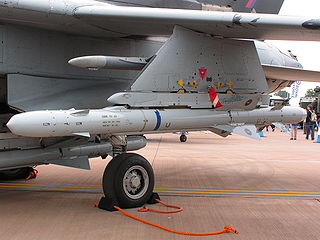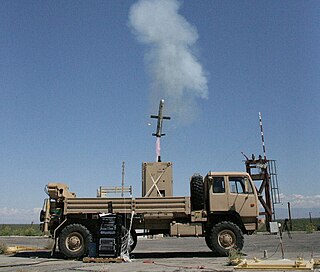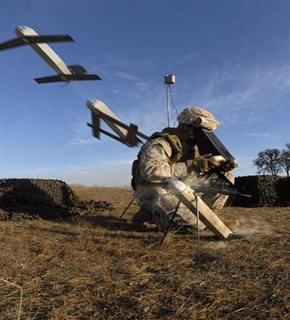Related Research Articles
The Joint Direct Attack Munition (JDAM) is a guidance kit that converts unguided bombs, or "dumb bombs", into all-weather precision-guided munitions. JDAM-equipped bombs are guided by an integrated inertial guidance system coupled to a Global Positioning System (GPS) receiver, giving them a published range of up to 15 nautical miles (28 km). JDAM-equipped bombs range from 500 to 2,000 pounds. The JDAM's guidance system was jointly developed by the United States Air Force and United States Navy, hence the "joint" in JDAM. When installed on a bomb, the JDAM kit is given a GBU identifier, superseding the Mark 80 or BLU nomenclature of the bomb to which it is attached.

Storm Shadow is an Anglo-French low-observable, long-range, air-launched cruise missile developed since 1994 by Matra and British Aerospace, and now manufactured by MBDA. Storm Shadow is the weapon's British appellation. In French service, it is called SCALP-EG. The missile is based on the French-developed Apache anti-runway cruise missile. They differ in that the Storm Shadow carries a warhead instead of submunitions.

ALARM is a British anti-radiation missile designed primarily to destroy enemy radars for the purpose of Suppression of Enemy Air Defenses (SEAD). It was used by the RAF and is still used by the Royal Saudi Air Force. The weapon was retired by the UK at the end of 2013.

The Exocet is a French-built anti-ship missile whose various versions can be launched from surface vessels, submarines, helicopters and fixed-wing aircraft. The Exocet saw its first wartime launch during the Falklands War.

The Type 45 destroyer, also known as the D or Daring class, is a class of six guided missile destroyers built for the United Kingdom's Royal Navy in the early 21st century. The class is primarily designed for anti-aircraft and anti-missile warfare and is built around the PAAMS air-defence system utilising the SAMPSON Active electronically scanned array (AESA) and the S1850M long-range radars. The first three destroyers were assembled by BAE Systems Surface Fleet Solutions from partially prefabricated "blocks" built at different shipyards; the remaining three were built by BAE Systems Maritime – Naval Ships. The first ship in the Daring class, HMS Daring, was launched on 1 February 2006 and commissioned on 23 July 2009.

The Aster 15 and Aster 30 are a Franco-Italian family of all-weather, vertical launch surface-to-air missiles. The name "Aster" stands for "Aérospatiale Terminale". It also takes inspiration from the word "aster", meaning "star" in Ancient Greek. The missiles as well as the related weapon systems are manufactured by Eurosam, a consortium consisting of MBDA France, MBDA Italy and Thales.

Brimstone is a ground or air-launched ground attack missile developed by MBDA UK for the UK's Royal Air Force. It was originally intended for "fire-and-forget" use against mass formations of enemy armour, using a millimetre wave (mmW) active radar homing seeker to ensure accuracy even against moving targets. Experience in Afghanistan led to the addition of laser guidance in the dual-mode Brimstone missile, allowing a "spotter" to pick out specific and the highest priority targets, particularly useful to minimise collateral damage when friendly forces or civilians were in the area. The tandem shaped-charge warhead is much more effective against modern tanks than older similar weapons such as the AGM-65G Maverick. Three Brimstones are carried on a launcher that occupies a single weapon station, allowing a single aircraft to carry many missiles.

The AgustaWestland Apache is a licence-built version of the Boeing AH-64D Apache Longbow attack helicopter for the British Army Air Corps. The first eight helicopters were built by Boeing; the remaining 59 were assembled by Westland Helicopters at Yeovil, Somerset in England from Boeing-supplied kits. Changes from the AH-64D include Rolls-Royce Turbomeca RTM322 engines, a new electronic defensive aids suite and a folding blade mechanism allowing the British version to operate from ships. The helicopter was initially designated WAH-64 by Westland Helicopters and was later given the designation Apache AH Mk 1 by the Ministry of Defence.

The Non-Line of Sight Launch System (NLOS-LS) was a self-contained missile launcher system that was under development by NETFIRES LLC, a partnership between Lockheed Martin and Raytheon. Each Container Launch Unit (CLU) holds 15 missiles, and a self-locating networked communications system. CLUs can be linked for coordinated launching, with the missiles fired and controlled remotely via autonomous vertical launch. The weapon is roughly 2 metres tall.

The Zuni 5-inch Folding-Fin Aircraft Rocket (FFAR), or simply Zuni, is a 5.0 in (127 mm) unguided rocket developed by the Hunter-Douglas Division of Bridgeport Brass Company and deployed by the United States armed forces, and the French Air Force. The rocket was developed for both air-to-air and air-to-ground operations. It can be used to carry various types of warheads, including chaff for countermeasures. It is usually fired from the LAU-10 rocket pod holding four rockets.

The Otomat is an anti-ship and coastal defence missile developed by the Italian company Oto Melara jointly with Matra and now made by MBDA. The name comes, for the first versions, from the name of the two builders and, for the later versions, Teseo, from the Italian word for Theseus. The MILAS variant is an anti-submarine missile. In its latest version Mk/2E purchased by the Italian Navy is a medium range anti-ship missile and a ground attack missile.
The GBU-44/B Viper Strike glide bomb was a GPS-aided laser-guided variant of the Northrop Grumman Brilliant Anti-Tank (BAT) munition which originally had a combination acoustic and infrared homing seeker. The system was initially intended for use from UAVs, and it was also integrated with the Lockheed AC-130 gunship, giving that aircraft a precision stand-off capability. The Viper Strike design is now owned by MBDA.

The AGM-176 Griffin is a lightweight, precision-guided munition developed by Raytheon. It can be launched from the ground or air as a rocket-powered missile or dropped from the air as a guided bomb. It carries a relatively small warhead, and was designed to be a precision low-collateral damage weapon for irregular warfare. It has been used in combat by the United States military during the War in Afghanistan.

Cirit is a laser-guided 70 mm missile system under production by Turkish arms industry manufacturer ROKETSAN. It is one of the projects launched by Turkey to equip the Turkish Army's T-129 Atak, AH-1P Cobra and AH-1W Super Cobra attack helicopters with low-cost precision strike capabilities. It has been selected by Eurocopter for execution of a test and integration program to equip the Eurocopter EC635. The weapon's name comes from a traditional Turkish horseback game, Cirit, where two teams of riders fight a mock battle using wooden javelins which are called cirit.

The IAI Harop is a loitering munition developed by the MBT division of Israel Aerospace Industries. Loitering munitions are designed to loiter above the battlefield and attack targets by self-destructing into them.

The AgustaWestland AW159 Wildcat is a British military helicopter. It is an improved version of the Westland Super Lynx designed to serve in the battlefield utility, search and rescue and anti-surface warfare roles. In British service, common variants are being operated by both the Royal Navy and British Army, having replaced their Lynx Mk.7/8/9 predecessors. The AW159 has also been offered to several export customers, and has been ordered by the Republic of Korea Navy and the Philippine Navy.

The AeroVironment Switchblade is a miniature loitering munition, designed by AeroVironment and used by several branches of the United States military. Small enough to fit in a backpack, the Switchblade launches from a tube, flies to the target area, and crashes into its target while detonating its explosive warhead. The name switchblade comes from the way the spring-loaded wings are folded up inside a tube and flip out once released.

Sea Venom is an Anglo-French lightweight anti-ship missile developed by MBDA to equip the French Navy and the Royal Navy. The missile is known as Anti-Navire Léger (ANL) in France and Sea Venom in the United Kingdom. While initial operating capability had been expected with the Royal Navy in 2022, Sea Venom missiles were reported deployed with Royal Navy Wildcat helicopters operating as part of the Royal Navy's carrier strike group in 2021. The first test launch, from an AS365 Dauphin helicopter of the French DGA defence procurement agency, was successfully conducted on 21 June 2017.
A loitering munition is an aerial weapon system category in which the munition loiters around the target area for some time and attacks only once a target is located. Loitering munitions enable faster reaction times against concealed or hidden targets that emerge for short periods without placing high-value platforms close to the target area, and also allow more selective targeting as the attack can easily be aborted.
MBDA UK is the British division of the pan-European missile systems company MBDA. Formed in 2001, the company has produced a range of missile systems, including the CAMM missile family, Storm Shadow cruise missile, ASRAAM air-to-air missile and Meteor beyond-visual-range missile (BVRAAM).
References
- ↑ "MBDA delivers first Fire Shadow loitering weapons". Flightglobal . Retrieved 21 March 2012.
- ↑ "House of Commons Written Answers". Hansard. UK Parliament. 11 July 2011.
- ↑ "Fire Shadow Takes To The Sea". Aviation Week. Retrieved 21 March 2012.
- ↑ "TYPE 45 - The Anti-Air Warfare Destroyer" (PDF). Royal Navy. 22 January 2009. Archived from the original (PDF) on 18 April 2009. Retrieved 2010-06-08.
- ↑ MBDA propose une munition rodeuse pour les marines (in French), Mer et Marine, 16 September 2011, retrieved 5 April 2012 Includes a video of a Chinook helicopter landing on a ship similar to HMS Ocean to deliver a Fire Shadow canister, which is then lashed to the deck and fired.
- 1 2 Eshel, Tamir (14 September 2011). "British Army Sets to Deploy Fire Shadow Loitering Weapons to Afghanistan by Early 2012". Defense Update. Retrieved 5 April 2012.
- 1 2 "After Libya, Europe Eyes Precision Arms". 23 September 2011.
- ↑ Hoyle, Craig (21 Mar 2012). "MBDA delivers first Fire Shadow loitering weapons". London: Flight International.
- ↑ Hoyle, Craig (10 Jan 2013). "Fresh delay hits UK complex weapons programmes". London: Flight International.
- ↑ "Major Projects Report 2014 and the Equipment Plan 2014 to 2024" (PDF). National Audit Office. Retrieved 13 January 2014.[ permanent dead link ]
- ↑ Bureau (25 July 2018). "UK Scraps Fire Shadow Loitering Munitions Program Incurring Loss of $148 Million". Defense World. Retrieved 27 Dec 2021.
{{cite web}}: CS1 maint: url-status (link)